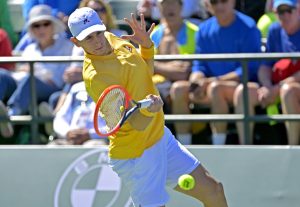After the BBC/Buzzfeed match-fixing inquiry that attacked tennis’ image in early 2016, the tennis authorities reacted announcing for Independent Review of Integrity in Tennis. The IRP should have “reviewed the effectiveness and appropriateness of the Tennis Anti-Corruption Programme (TACP), the Tennis Integrity Unit (TIU) and the Tennis Integrity Protection Programme (TIPP) and recommended any suggested changes.” After 18 months, the IRP hasn’t issued any document or statement, and this already should show the lack of effort and transparency of the review.
Last week, the attention of the media was caught again by a tennis match played at the Winston-Salem ATP event. You can read the details of the match perfectly explained here and to cut a long story short, this is the graph of Alexandr Dolgopolov‘s price on Betfair
Dolgopolov's price on Betfair… pic.twitter.com/nZbiFcQXDc
— jimmy soixante-dix (@hotdog6969) August 20, 2017
The Ukraininan passed from clear favourite to clear underdog just a few hours before the match, he played a full match without showing any sign of injury (he didn’t receive any medical treatment during match), and got easily routined. The Tennis Integrity Unit has opened an investigation but we all know what happened to last public investigation announced about Vitalia Diatchenko’s match at US Open 2016: despite all the alerts sent to tennis authorities by Federbet (an organization that monitors suspicious gambling movement), the Russian kept playing for the whole 2017 without any problem with TIU hiding again behind their classic sentence
there are many reasons other than corrupt activity that can explain unusual betting patterns, such as incorrect odds-setting; well-informed betting; player fitness, fatigue and form; playing conditions and personal circumstances
None of the above reasons seem applicable to Dolgopolov’s case.
Pinnacle, one of world biggest bookmakers, decided to void bets placed on the Dolgopolov match because of abnormal and suspicious betting activity.
Anyway, only a few noticed that a couple of hours before the Dolgopolov match, something weird happened in a WTA match in New Haven: Ukrainian Kateryna Bondarenko was playing her last round qualifying match and bookmakers rated her the slight favourite against Ana Bogdan. As soon as the match started, you could notice abnormal betting patterns on every bookmaker, especially Bet365 and Betfair–where Bondarenko, after four games played and with the score at 2-2, was priced 3.5 (instead of about 2 that you would have expected). She went on to lose the match 6-2 6-2.
Something wrong here….bet365 also removed 1st set…someone knows Bondarenko is sold or crippled pic.twitter.com/bLhEwWiRIP
— Stefano Berlincioni (@Carretero77) August 20, 2017
Bet365 removed quickly 1st set market and lowered Money Line limits to avoid the risk of other big bets against Bondarenko.
A few days later again Pinnacle refunded bets placed on the match.
Pinnacle voided all the bets on the Bondarenko match https://t.co/WbQqTtmowH pic.twitter.com/5EWWYtlkCN
— Stefano Berlincioni (@Carretero77) August 22, 2017
Pinnacle decided to void bets for the same reason also a few weeks ago in a first round match in the Portoroz Challenger between Attila Balazs and Adrian Menendez Maceiras: according to bookmaker alerts, the match could have been fixed by the Hungarian (line under 21.5 games). Bet365 removed the 1st set market and other markets, heavily lowered limits on ML. Balazs started appearing injured at 5-5 in first set, got broken easily, called Medical Time Out and didn’t win another game (but kept playing) until 5-7 0-6.

Talking about the ATP Challenger Tour, I have recently noticed the presence of a bunch of Russian players that have barely any ITF activity but that started signing-in for Challenger qualies.
One of them is Anton Chekhov, and again in Portoroz, bookmaker alerts were issued on the 6-0 score of the second set in his qualifying match against Albano Olivetti. For those that doesn’t know him, Olivetti is a sort of poor man’s Isner, a player that has really low probability to win a set by bagel. After Olivetti won the first set 6-3, Chekhov lost the second set without managing to have any break/game points.
A few weeks later, again, Chekhov played in the qualifiers of the Meerbusch Challemger against local Wild Card Kai Breitbach and after winning first set 6-3

Bet365 suspended odds and then removed set 2 market

and he quickly went 0-3* and easily lost the second set

Then he tried to win the match but failed and lost 6-7 (some karma in action maybe).
Anyway, he is not the only one Russian with very suspect Challenger qualies activity, so I hope these player will soon be under the micropscope.
Last, but not least, the ITF Pro Circuit, about which I wrote several articles.
Do you remember the habit of heavy favourite players losing the 1st set (with 1st set market removed by bookmakers) and then cruising to the win?
Also here 1st set market removed and Osama as 1.02 prematch favourite loses it 1-6 pic.twitter.com/w1Xjwdiuzd
— Stefano Berlincioni (@Carretero77) August 2, 2017
It seems it’s still happening.
Do you remember the habit of players seemingly betting on themselves and retiring on the verge of defeat to have bets refunded?
Bet365 removed early set winner score and cut ML limits, Chazal probably had some big bet on himself and retired 0-5 down tiebreak pic.twitter.com/Wj7aKaaSKg
— Stefano Berlincioni (@Carretero77) August 18, 2017
It seems it’s still happening.
Do you remember the habit of players that are heavy favourites just throwing matches?
1st set market removed, ML limits heavily cut…and 1.08 pre lose 0-6 1st set pic.twitter.com/RIWfZTqGF5
— Stefano Berlincioni (@Carretero77) August 8, 2017
It seems it’s still happening.
These are just a few examples of suspicious matches at every tennis level where bookmakers behaviour/alert and scores should lead to a deep investigation (I don’t have and can’t have any evidence like phone calls recorded, chats, bank account movements; it’s not my job to find this evidence), but the big question is again the same: will the tennis authorities really investigate or they will just keep caring about protecting the clean image of the sport?
Editor’s Note: As always, no individual without witnessing activities firsthand can prove or be sure about potential match-fixing. As the ITF quote above says, there are many reasons that can explain unusual betting patterns. As such, none of this evidence should be treated as direct accusations against players in question. However, when the most likely explanation for betting patterns is corrupt activity, there is an absolute obligation upon the sport’s governing body to research it fully, and not to brush it away. This is the point of Stefano’s research, which is so strong that it cannot be ignored.






